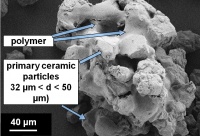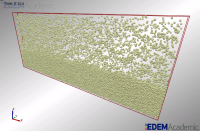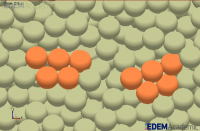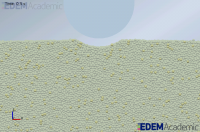Michael Szelwis: "Particle-reinforced composites simulated by cohesive discrete elements"
For the research on a ceramic-polymer-composite (TiO2 in a PMMA matrix) with very high content of ceramic particles a numerical model is being investigated. To simulate the nonlinear deformation due to indentation a discrete element approach has been chosen with each ceramic particle being represented by one particle in the simulation. Several models for the interaction of the ceramic particles with one another as well as with the polymeric matrix, such as cohesion and physical bonds, are being tested using the software package EDEM and are also being compared with experimental results.
Содержание
Previous Work
Simulating the mechanical behaviour of the investigated material, Hertzian contacts between the particles were combined with EDEM's default bond model representing the polymeric matrix. Indentation tests revealed qualitative accordance to experimental results within the region of elastic deformation of the specimen. It was shown that a stiffer material used for the polymeric matrix, which has been modelled with bonds of higher Young's modulus, leads to a higher stiffness of the specimen.
Performing large deformations within the simulation, the created specimen deforms elastically until the stress in the bonds reaches a previously defined threshold value. Bond breakage occurs after exceeding this threshold and the interaction between the particles becomes purely Hertzian. For this region where deformation becomes plastic, the stress-strain behaviour of the model doesn't represent the real material's behaviour anymore.
Representing Polymer by Cohesion of Primary Particles
The main problem of using bonds simulating the material's plastic behaviour is that in this case, particle rearrangement always goes along with the breakage of bonds and therefore with a drastic change of the simulated material's properties. Plastic deformation is generally associated with so-called dislocation movement where the atoms of the material rearrange during deformation due to imperfections in the crystal structure. During this process energy dissipates but the mechanical properties of the material remain more or less unchanged. Therefore, it would be desirable for a model which is supposed to represent the investigated ceramic-polymer-composite, to contain consistent particle interactions before and after the relocation of particles.
The Cohesion of primary particles is an implemented contact model in EDEM in which the simulated attractive force between particles does not change with their relocation. Also, it represents how we generally understand the constitution of substances on an atomic scale. Consequently, it might be suitable to model the mechanical properties of the investigated material including elastic as well as plastic behaviour. Nevertheless, it is questionable if this approach can predict the properties of the material when used on a very large scale where each particle in the simulation represents one ceramic particle embedded in a matrix of polymer.
Particle Forces
To keep the calculations as simple as possible first simulations were run using the default Hertz-Mindlin contact model as well as the model for particle cohesion which are provided within EDEM. In this case the Hertz-Mindlin-Force between two equivalent particles in contact gets calculated as follows:
with and being the Young's Modulus and the Poisson's Ratio of the particles, being their radius and being the normal overlap assuming the particles remain spherical when in contact. Considering this assumption, the Particle Cohesion calculates:
with being a constant parameter of the cohesive force (also referred to as energy density).
This leads to the Total Force between two interacting particles of
If attractive and repulsive forces are of the same magnitude the total force and the particle contact reaches an equilibrium state with an equilibrium overlap . Besides the trivial solution there might be found a second solution for which the particle contact becomes stable:
- with
- with
Substituting () leads to
- where
Resubstituting leads to This means that this second equilibrium distance can not be adjusted to which would not just be suitable for the intended simulations. Also, this is the only range for which EDEM calculates the particle forces which means that with the indicated formulas, an equilibrium distance of two interacting particles can never be reached.
While a stable configuration for indentation experiments can still be reached (high friction between particles prevents them from collapsing) the simulation of a bending experiment will not be possible. To eliminate this problem a modified cohesion model with a larger radius for the calculation of cohesive forces than the particle radius will be considered in future simulations (see below).
Specimen for Simulation of Indentation
Determining the Rockwell Hardness of a material, a spherical indenter impresses on the surface of the investigated specimen. In response, the tested material deforms elastically and plastically, assuming the indentation force is large enough, and it will be left behind a circular crater on the surface of the specimen after having removed the indenter. Assuming circular symmetry of the materials response to the Rockwell indentation, present simulations have been reduced to a quasi-two-dimensional setup, representing one cross-sectional area of the real 3D-experiment. Analogous to the cosine being approximately constant around the angle of , the third dimension within the simulation will be approximated by using a cylindrical indenter-geometry as well as applying periodic boundaries in Y-direction (see figure showing indentation experiment). The quasi-two-dimensional section was chosen to have a width of five times the diameter of the primary particles which is small compared to the size of the indenter but it still allows the particles to form crystalline areas (see figure of selected particles). This might be a fundamental property for a reasonable simulation of plastic deformation.
Even if the applied periodic boundaries in X-direction (see figure showing indentation experiment) do not have such a mathematically aesthetic justification like the ones in Y-direction, they most likely represent the real situation better than rigit- or free-boundary-conditions would do.
The specimen were created by randomly generating particles (10,000 or 40,000) over a certain period of time and within the observed area (see figure of specimen creation). Due to gravity and the cohesion of particles a reasonably close packing with a packing factor of 0.63 has been reached. Before starting indentation the specimen was smoothed by pressing it using a flat geometry.
Results
Simulations revealed the possibility to qualitatively predict a material's response due to indentation by approximating the structure of the investigated material using discrete particles applying Hertzian contact laws, linear cohesion as well as linear friction. Furthermore, this concept is comparable to how deformation processes are generally explained on an atomic scale which emphasizes the consideration of this approach. The fact that the particles in the simulation being of magnitudes larger than real atoms does not seem to have an impact on the qualitative results even though it involves a certain coarseness of the plastic area in which particle relocation occurs (see force-displacement curves of cohesion models with 10,000 & 40,000 particles).
Next Steps within this Work
- Quantitative comparison of the results with experimental data
- Realizing model with varying relevant radius for calculations of cohesive- and contact forces (at the moment it is impossible to reach equilibrium state)
- Performing bending test (with new model of varying radii)
- Ensuring the results do not change quantitatively by increasing the number of used particles
- Examining the suitability using the cohesive model for the investigation of hierarchic materials
Structure of Final Thesis
- Introduction (about the material and why simulations are desirabe)
- Background (DEM more suitable than FEM (what about MD?) - literature review)
- Methodology
- EDEM & contact models
- about EDEM
- BPM
- cohesion
- Hertz-Mindlin
- (V-model)
- Qualitative analysis of contact models
- instability of square lattice
- cohesion
- BPM (is it also instable under same conditions as cohesion?)
- bending test
- instability of square lattice
- Simulation of the macro-properties of the material
- creation of the specimen
- compression test (for calibration of bond model)
- small compression/adjust Young's modulus and Poisson's ratio (calibration of elastic behavior)
- large compression/calibration of plastic behavior
- indentation test for quantitative validation
- EDEM & contact models
- Results
- Future Work







